Pagewood Park Memories
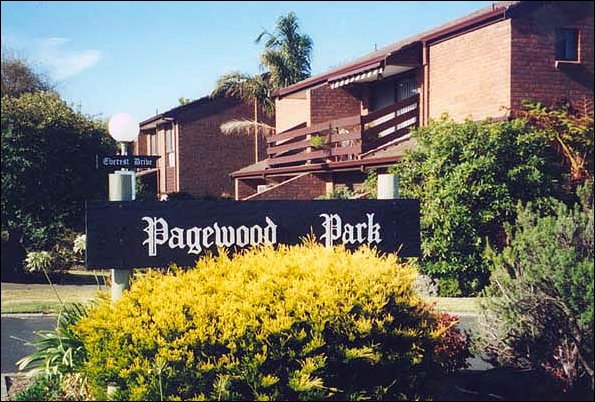
Pagewood Park.
Pagewood Park is built on 6.6 hectares of land previously owned by the Le Page family. The Le Pages have lived in Cheltenham since 1854 when Nicholas Le Page, a tailor from the Channel Island of Guernsey, bought two acres of land on Chesterville Road near Bernard Street to establish a market garden. Over the years the Le Pages purchased more land in the area. In 1875-76 Nicholas' son Frank and his wife Mary built 'Daphne Cottage' near the corner of Bernard and Wilson Streets.
In the 1940s Frank's son, Everest Le Page, bought five more lots of land in Chesterville Road from the Tuck family. The Le Pages grazed horses, ponies and cows on this land, and grew pumpkins, carrots, parsnips, onions, potatoes and cabbages here.
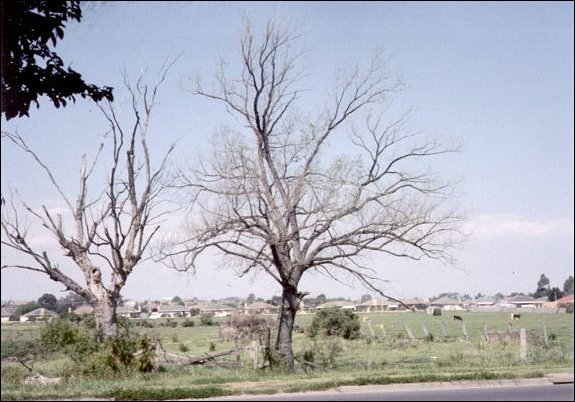
The Le Page property from Chesterville Road, Cheltenham 1975.
After the death of Everest, the Le Page family decided to sell this land. According to Everest's son Len, 'we were only working it to pay the rates'. Len offered 16 acres of land to estate agents one morning, and by lunch-time B.M.(Bruce) Terry had bought it for housing development. The Le Page family maintained their interest in the land, and were anxious to see a development of which they could be proud. The family donated the block of land on which 'Daphne Cottage' had stood for about 100 years to the City of Moorabbin for the creation of 'Le Page Gardens'.
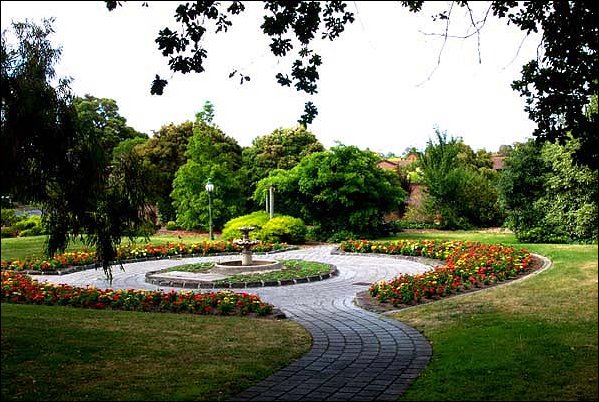
Le Page Gardens, 2002.
The name 'Pagewood Park' commemorates the Le Page family, and two streets in the estate are named after Everest Le Page and his wife, Lynda. Two members of the family now live on the estate: Jean Martin, daughter of Everest and Lynda, and her sister-in-law Pearl, whose late husband Theo Le Page was also an early resident of Pagewood Park.
Pagewood Park was one of the first estates built under the Cluster Titles Act 1974-75. In the early 1970s urban planners were attracted to 'planned unit developments' (as they were called in USA) or 'cluster housing subdivisions' (as they were called here). The Minister for Local Government in the Hamer Government invited an ad hoc committee, chaired by Mr (later Professor) David Yencken (architect, builder, developer and founder of Merchant Builders), to advise him on how to get around problems arising from the Strata Titles Act (which did not allow for this type of development). Yencken's committee produced two reports, containing requirements that were then developed into legislation.
In April 1974 the Cluster Titles Bill was introduced into the Victorian Parliament. The Minister of Public Works explained the concept of cluster housing to the Legislative Assembly with a description that sounds like a word picture of Pagewood Park:
“…the purpose of cluster housing is to allow the free siting of houses on an area of land in such a way as to take every advantage of natural characteristics… an imaginative designer will relish this opportunity to site each house without the need to conform to inflexible standards of grade, location of facilities and so on…It will also provide an opportunity, within the limitations of the financial resources of the average home-owner, to have a personal share in the enjoyment, and ownership, of amenities such as swimming pools and tennis courts which he could not aspire to a conventional suburban lot but which can be provided on the commonly owned open area of land. The owner will also have access to these open areas of land for passive recreation - the mere presence of such open areas almost literally at his front door is, for many, an exciting prospect.”
The Cluster Titles Bill was enacted in 1975. Pagewood Park was the largest cluster housing development in Victoria when it opened in 1978.
Developer and builder, B. M. Terry, had been introduced to the Le Page family by Ken Reed, surveyor, town planner and City of Moorabbin councillor. When Terry purchased the Le Page property Reed urged him to 'do something different' with it. He suggested an 'upmarket cluster estate'. Reed visited the West Coast of the USA to inspect planned unit developments, and in Kansas City he saw an estate with 800 units! When he arrived back home Terry listened to his suggestions, and gave K. A. Reed Pty Ltd, Project Consultants, 'an open hand' in the design of Pagewood Park. Reed's senior architect, Gary Catt, was responsible for the design and siting of houses, community facilities and landscaping. A generous 21% of the site was planned as 'communal open space'.
The original design included 39 three-bedroom two-storey townhouses. When the townhouses in the first few stages of the estate proved more difficult to sell than the single-storey houses the Scheme of Development was amended to omit townhouses from the later stages. B. M. Terry and Staff Pty Ltd built and sold the 142 houses in ten stages.
On 11 November 1977, the day before Pagewood Park opened for inspection, The Age published a full-page promotional article in which the developer enthused about the
“environment of gracious, spacious living among landscaped gardens and creatively planned homes. In six different designs, the homes are imaginatively arranged with no two houses directly face to face and no adjoining courtyards. You enjoy the privacy of your own courtyard as well as the open space and communal gardens without the backbreaking job of establishing and maintaining them. A live-in caretaker cares for that, the area's security and your home while you're away. You have more time to relax and entertain at the recreation area comprising a swimming pool, tennis courts, &c…”
The Premier, Mr Dick Hamer, officially opened Pagewood Park on 23 March 1978. He explained that 'I am here because I like the idea of people living in a community like this where they can take an effective role in what goes on around them.' Cr Frank Le Page and other members of the family attended the opening reception. Brian Dixon, Minister for Sport, Youth and Recreation, played an exhibition tennis match with Ron Clark as an added attraction to the opening ceremony, and to promote the 'Life: be in it' campaign.
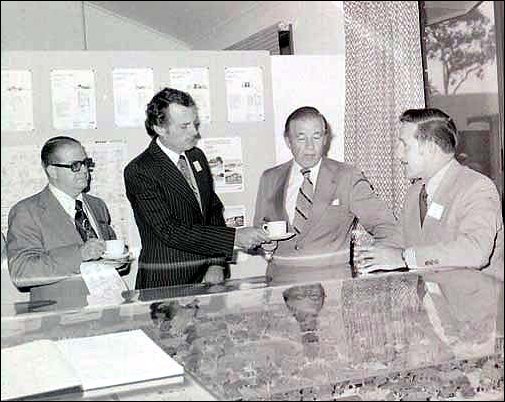
The Premier of Victoria, Hon Dick Hamer is briefed on the Pagewood Park project by Cr Ken Reed, 1978. Courtesy Leader Collection.
Many of the original owners still live in Pagewood Park. They came here because:
- 'My husband was unwell and we needed somewhere smaller where I could manage and do the lot.'
- 'We had more land than we wanted and a bigger house that needed attention.'
- 'I'd been widowed for a few years and had to think of my future.'
- 'It looked like a great set up, with the pool, security, the right price and we could bring our dogs.'
- 'The layout of the estate was attractive.'
- 'The house itself appealed.'
- 'We could walk to Southland.'
A Committee of Management was set up in 1979. The first committee established the original by-laws for Pagewood Park. Meetings were held in the evening to enable members who worked daytime hours to participate. Body Corporate fees were originally $45 a quarter, which included the provision of garden maintenance as well as lawn-mowing. Plants were mainly Australian natives. When residents replaced the natives with exotic plants the gardening costs increased and the committee decided that residents would be responsible for their own garden maintenance.
- B. J. Smith and Associates provided secretarial services from 1979-85.
- AGM notices in the early years requested 'Please bring your own chair or stool.'!
- The 1981 AGM began at 7.30 pm and finished at 10.45 pm!
- Herman Klein of Victoria Body Corporate Services was appointed Secretary and Accountant to the Body Corporate in 1986.
- Gas was installed on the estate in 1994.
- Solar heating for the swimming pool was installed in 1998.
- An 80cm TV and VCR were purchased for the Community Centre in 1999.
- The tennis courts were redeveloped as croquet and tennis courts in 2000.
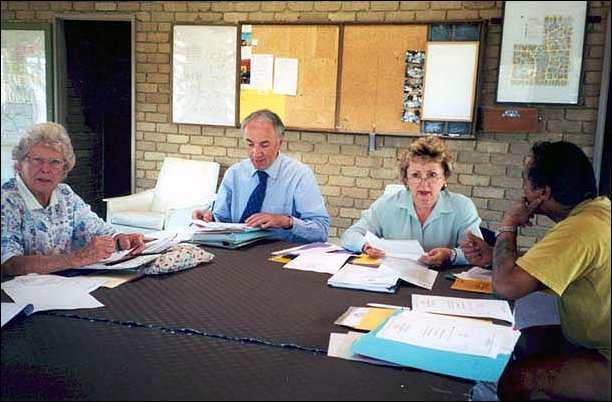
Committee of Management : Zelda, Herman, Helen and Rex. Courtesy Joan Kenny.
Claris Maddern and other early residents formed a Social Sub-Committee in 1979, and, with an advance of $50 from the Committee of Management to purchase carpet bowls, the Social Committee began to provide a range of activities, including:
- Afternoon teas in the Community Centre every second Wednesday,
- Pagewood Park birthday parties in March, with a pig-on-a-spit; attendances were large in the early years - 119 at the 5th birthday party in 1983!
- Christmas lunches - in the early years it was BYO everything, including card tables set up outdoors under beach umbrellas, plates, knives, forks, glasses etc. Father Christmas came (alias Ed Payne, Bertie Morgan, and the skinny one, Norm Walsh),
- Holiday trips to Merimbula, Swan Hill and Marysville,
- Day coach trips to play the pokies at Langwarrin Hotel and NSW border towns, and trips to the pictures at Pinewood Theatre, Waverley,
- Cup Eve and Derby night get-togethers, and more recently, New Year's Eve gatherings in the Community Centre,
- 'Stay-puts' casserole dinners for those who didn't annually escape Melbourne's winter,
- Bingo once a month, called by Doug Starke, Wilma Nichol and Norm Walsh,
- Carpet bowls,
- and since about 1998, 'Happy Hours' on the first Friday of the month (with the men sitting at their own table, in the old Aussie tradition).
Like most neighbourhoods, Pagewood Park has had its share of neighbourly disagreements as well as kindnesses, deep sadnesses as well as good laughs. Some of the positives include:
- The building of the pergola on the Community Centre by Committee members
including Dave Perriman, Theo Le Page and Len Huxtable, - Cooling off in the pool after a hot day's bowling. Many residents are/were
bowlers at Cheltenham, Sandringham, Beaumaris and Hampton clubs. In the early
days 'we'd come home after bowls and cool off in the pool and exchange news.
Then people began to put in air conditioning, and we got a bit lazier…' - April working bees on gardens on common property,
- Generous support for Cancer Council Morning Teas in May,
- The assistance of caretakers, including Arthur Tennant, Ron Roche and Rex
Whannau.
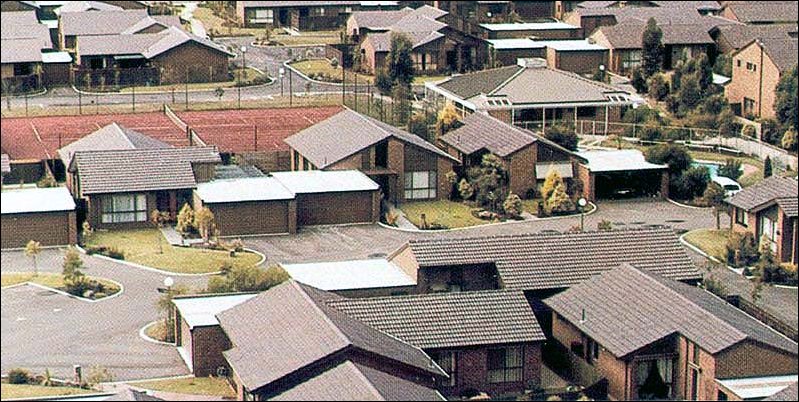
Tennis Courts, Community Centre and Residences at Pagewood Park, c1980 Courtesy Joan Kenny.
Footnotes
- Thanks to the residents who contributed information and memories for this brief history of Pagewood Park: Joyce Box, Eve Caplan, Nona Currie, Len Huxtable, Pearl Le Page, Cath McIntosh, Wilma Nichol, Gwyn Robertson, Kath Starke and Norm and Dorothy Walsh. Dr Graham Whitehead, Kingston City Historian, Len Le Page and Ken Reed also provided valuable information. The City of Kingston Historical Website contains information on the 1852 auction and subdivision of the land purchased by the Le Page family.
